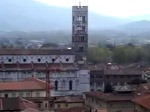 Course: Art History FSP in Florence
Course: Art History FSP in Florence
Instructor: Prof. Adrian Randolph
With the support of a Robert S. Cheheyl ’38 and R. Stephen Cheheyl, Jr. ’67 Fellowship for the Application of Technology in Teaching and Learning (Dartmouth College), students participating in the 2002 Art History Foreign Study Program in Florence (Italy) were asked to produce videos as part of their coursework. The students were split up into groups of three or four and each group produced two videos.
The first were intended to be relatively straight-forward exercises, in which a theme with clear parameters would enable students to mingle video with simple descriptions and narratives. These first videos were also seen as an opportunity for students to develop a familiarity with the technology–the digital video cameras and, especially, with iMovie, the editing program we were using. I urged the groups to work together, but also to divide tasks among themselves. In this manner, each student could develop a proficiency in one area of production.
The second videos, although only slightly longer than the first (seven minutes, instead of five) tackled broader themes. I also encouraged the students to be more adventurous in terms of how they captured and edited the video, and in terms of the genres within which the chose to work. Thus, instead of producing videos based on what, for art history, might seem the natural historical-documentary mode, I urged the students to experiment with other modes. For this second project, I also required students to submit bibliographies, and individual essays, based on a portion of the materials they were examining in the video.
The projects were, I think, a great success. The students were excited about working with video and the level of their intellectual commitment was truly inspiring. The products, although occasionally rough, demonstrate the verve with which they approached their work.
Video is well suited to examining visual culture in situ. The technology seems to compel those using it to dwell upon the visual and engage with it actively. Thus, video seems to have enhanced the student’s appreciation of what lies at the core of our Foreign Study Program, and of Art History as a discipline.

